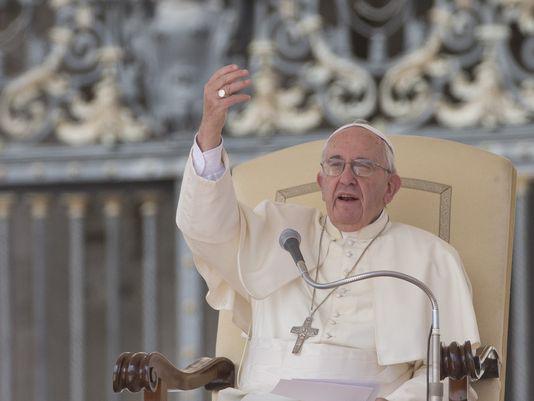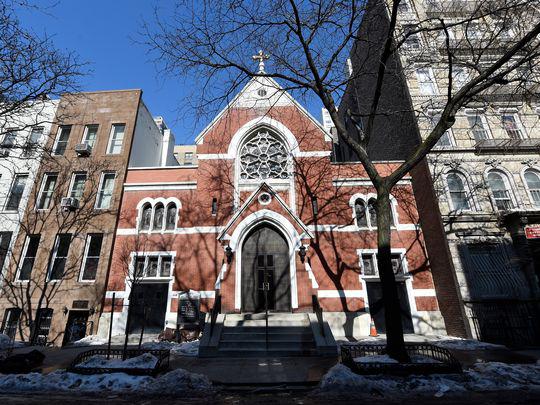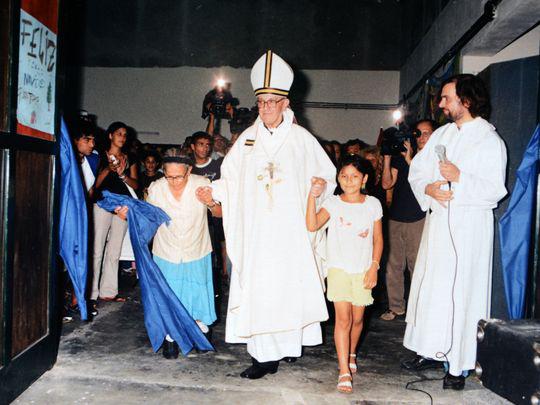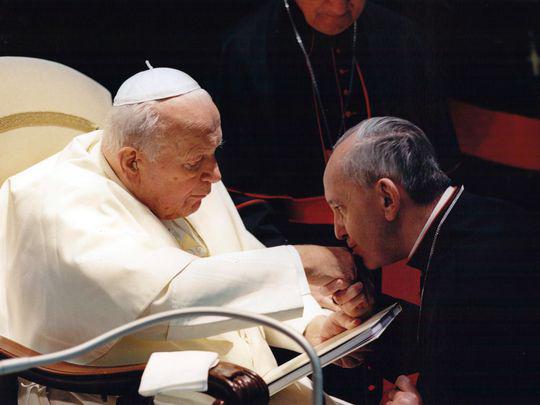|
Pope Francis will face a fractured U.S. Catholic Church
By Rick Hampson
NEW YORK — The pope is coming to town, and ordinarily parishioners of Our Lady of Peace Church would be focused on trying to get tickets to the papal Mass at Madison Square Garden. Instead, they’re focused on trying to reverse the decision to close their parish. Our Lady of Peace is one of scores of parishes closed or merged this year by the Roman Catholic Archdiocese of New York, which Pope Francis visits Sept. 24 after a stop in Washington and before heading to Philadelphia for the World Meeting of Families. Parishes like Our Lady of Peace epitomize the challenge facing Francis on his first U.S. visit: an American church in a slow-moving crisis of flagging membership, fewer priestly vocations and school and parish closings — all exacerbated by the lingering effects of the clergy child abuse scandal. “It’s great the pope is coming, but look at all the closed churches,” says Janice Dooner Lynch, whose family joined Our Lady of Peace in 1921, two years after the parish was founded. “Our main concern now is, ‘What about us?’" A survey of American religious affiliation released this spring by the Pew Research Center found that Catholics make up 20.8% of the population, down from 23.9% in 2007. For every convert, six others have left the faith. There are about 3 million fewer adult Catholics than eight years ago. Nearly 13% of all Americans are former Catholics — people raised in the church who no longer identify with it. U.S. Catholic school enrollment has declined from its peak of more than 5.2 million students 50 years ago to about 2 million. In the past 10 years, 1,648 Catholic elementary and secondary schools — about a fifth of the total — have closed or consolidated. Several schools in regions the pope is visiting closed at the end of the last school year, including Pius X High School in Bangor, Pa., which closed after six decades, and Most Precious Blood Elementary in Astoria, Queens, which was whipsawed by rising building costs and declining enrollment. There are about 20,000 fewer U.S. Catholic priests than in 1965, a 34% drop, even though the Catholic population is 50% larger. The Center for Applied Research in the Apostolate in Washington says about 3,500 of 17,500 parishes have no resident priest, twice as many as 25 years ago. This year, the four parishes in Atlantic City, N.J., were consolidated into one. Soon there will be even fewer priests to go around. The Rev. Thomas Reese, who writes for the National Catholic Reporter, asks, “Is the Catholic Church going to turn into a series of local megachurches?” So far there is almost no evidence of what some hopefully called “the Francis effect,” such as a measurable surge in Mass attendance or church affiliation due to the new pope’s popularity. Even that popularity has slipped. According to a Gallup poll released in July, 59% of Americans view the pope favorably, down from 76% in February 2014, and about the same as after he was elected in March 2013. Among Catholics, his status is murkier. In July, Gallup had Francis’ approval rating at 71%, down from 89% in early 2014. But in June, Pew had it at 86%, and in August a poll by the Public Religion Research Institute and Religion News Service had it at 90%. QUIZ: How much do you know about popes? That last survey suggests U.S. Catholics may see Francis as their best hope for reversing the national church’s institutional slide. Eight in 10 say he understands the needs and views of the American Catholic community somewhat or very well. Only six in 10 Catholics say the same of U.S. bishops. Hope is one thing. What can a pope whose humility, piety and candor have made him a hero to non-Christians around the world actually do to shore up his own church in America? “That’s the big question. The answer is, ‘Not enough,’ ” says David Campbell, a Notre Dame political scientist and co-author of American Grace: How Religion Divides and Unites Us. “The pope is very popular, but almost everyone experiences religion in their local congregation, and there aren’t changes yet at that level.” ‘WHO AM I TO JUDGE?’ The Argentine who was known as Cardinal Jorge Mario Bergoglio has become one of the world’s most fascinating public figures since his surprise election as pope in March 2013 after Benedict XVI unexpectedly retired. He immediately became famous for his openness and relative informality. He lived in a modest guesthouse instead of the palatial papal apartments; he telephoned rank-and-file Catholics out of the blue; he tweeted. Before Easter, he went to a prison and washed the feet of inmates, including Muslims. Flying to Rome after World Youth Day in Brazil, he told reporters: “If someone is gay and he searches for the Lord and has good will, who am I to judge?” In an interview, he said the church shouldn’t speak so insistently — he used the word “obsessed” — about culture-war issues such as abortion and homosexuality: “We have to find a new balance.” In another interview, he said that ”everyone has his own idea of good and evil” and should ”follow the good and fight evil as he conceives them” — a seeming rejection of a black-or-white view of morality. Asked last year about the role of women in Catholicism, the pope said they “must be more present in places of decision-making in the church.” Almost everything he says is news, including his comment that the big bang theory of the universe’s origin was consistent with Catholic theology and cosmology — even though he was merely repeating a position announced in 1951 by Pope Pius XII and reiterated by several popes since. In his first appointment to fill a major U.S. post, Francis named Spokane Bishop Blasé Cupich to replace retiring conservative Cardinal Francis George as archbishop in Chicago. Cupich had a reputation as a moderate, conciliatory prelate who had asked his priests not to pray in front of abortion clinics because it was too provocative. The pope has decried “the idolatry of money” and denounced economic inequality produced by unfettered capitalism. And this year, he marched directly into politics with an encyclical linking climate change in part to human activity. This all has encouraged church progressives and discouraged traditionalists. But the net result seems to be something like this: Progressives are hopeful, but unhappy with the church on the ground, which is still controlled by traditionalists; conservatives still respect the papacy, but are increasingly worried about Francis’ liberal tendencies. According to Gallup, Francis’ drop in favorability is stark among Americans who identify as conservative. Only 45% view him favorably, vs. 72% last year. “Many American Catholics have shifted to the right,” says Campbell, the Notre Dame political scientist, “and now this pope is saying, ‘Let’s emphasize something else.’” But the pope’s image also has taken a hit among liberals, some of whom have criticized him for not embracing ordination of women or allowing priests to marry, and for his opposition to abortion and denunciation of efforts to “redefine” the family as something other than one headed by a married man and woman. Even this may add to his general allure. “There’s always a feeling that the pope just might surprise you,” says Robert Jones, CEO of the Public Religion Research Institute. Gallup says Francis’ 59% overall favorable rating among Americans exceeds Pope Benedict XVI’s 40% in 2010. In contrast, Pope John Paul II, who served for nearly 27 years, always polled above 60% in the 1990s and 2000s, and reached a high of 86% favorability in late 1998. In the Gallup poll, 25% of respondents said they had no opinion about Francis or had never heard of him, up from 16% in February 2014. Almost one in five respondents in the PRRI/NRS survey offered no opinion. That should change after Francis’ visit. “A pope is always going to be wildly greeted by American Catholics,” Campbell says. “Pope Francis generates excitement among non-Catholics.” PRAYING FOR A MIRACLE Our Lady of Peace’s redbrick, 1866-vintage building closed July 31 after the parish was merged with another on Manhattan’s East Side. Janice Dooner Lynch and others held a candlelit prayer vigil outside. Lynch was married there, as were her grandparents and her parents. She, her daughter, her mother and her uncle were baptized there. The funerals of her father and grandparents were held there. But last year it was classified as an “unneeded” parish. “We have too many parishes!” Cardinal Timothy Dolan wrote in an exclamation-packed pastoral letter. “We no longer need 368 parishes in their current locations! … There are 29 parishes in the South Manhattan Vicariate alone—all concentrated on 14th Street or below!” Dolan said that although his archdiocese has been spending $40 million a year to support such parishes, it’s not just money — the archdiocese will soon face a critical shortage of priests to administer its parishes and must consolidate. To Lynch, there’s always hope until the parishioners’ appeal to the Vatican to keep Our Lady of Peace open is denied. She wishes Pope Francis would take an interest in the case during his visit, although she admits that — given the number of parishes being closed — that would take a miracle. Still, Lynch said, “this has caused so much heartache and anger. So I pray all the time that this comes to his attention.”
|
.
Any original material on these pages is copyright © BishopAccountability.org 2004. Reproduce freely with attribution.



